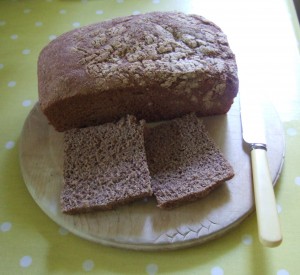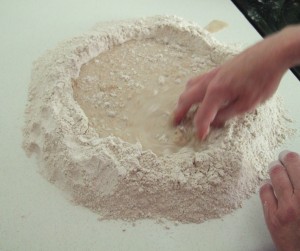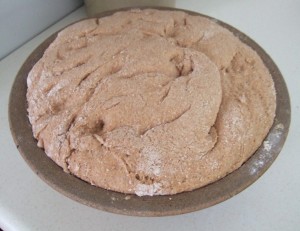I wanted to use the lovely wholemeal flour we bought the other week from Sturminster Newton Mill, and found a recipe online for Dutch wholemeal bread which seemed straightforward and hopefully foolproof. I haven’t had much success with bread making (we’re talking bricks, not airy doughy delights) and so approached with trepidation. I have doubled the amounts to make two loaves.
Ingredients (makes 2 loaves):
1 kg wholemeal flour
20 g salt
600 ml cold water
40 g tbsp live yeast
additional 200 ml water
olive oil
Preparation:
Measure out the flour and salt and mix into a pile on a clean flat work surface. Using your hands, make a well in the middle, making sure that all sides of this ‘dike’ of flour and salt is of an even thickness, so that the dam won’t break when you add the water. The well should measure about 8 inches across (about 20 cm), which is roughly the length between the tip of your thumb and the tip of your pinky finger when your hands are stretched out and your fingers are spread as wide as they can go.
Dissolve the fresh yeast in the water, by rubbing the yeast between your thumb and your forefinger until it’s completely dissolved. Add the water to the well. Just add a bit at first to see if the dike holds, and if it does, add the rest. Using the tips of your fingers start amalgamating the inner edges of the flour with the water and upping your tempo keep mixing until it starts forming a thoroughly mixed dough.
Now start kneading the dough, pushing it away from you with the ball of your hand and using your fingers to bring it back towards you. Try to keep a good tempo here and knead for 15 minutes (you can also use a mixer with a dough hook attachment). Add up to 200 ml of additional water, making sure the dough is wet but not sloppy. After 15 minutes of kneading, the dough should feel wet and supple (spongy), but not sticky. If you stretch the dough into a ball you shouldn’t be able to see cracks on the surface and you should be able to stretch it (this means that the gluten has been activated).
Form a ball with the dough and wrap it in a (clean) warm, damp tea towel. Allow to rise for 30—45 minutes at room temperature. The dough will increase by about ⅓ in volume. Remove the tea towel, pummel the dough with your fists and then form it back into a ball, wrap in the tea towel and again allow to rise for 30—45 minutes.
Grease a bread tin with olive oil. Wet the work surface with some water. Remove the tea towel from the dough and press the dough flat onto the wet work surface. Form the dough into a sausage shape with your hands, so that it is roughly the same length as the bread tin and place into the bread tin. Cover the bread tin with the warm moist tea towel and allow the bread to rise for another 30 minutes until it has increased by ⅓ in volume.
Meanwhile, preheat the oven to 220º C. Reduce temperature to 200º C and place the bread in the oven. Bake for 35—40 minutes. Remove the bread from the tin. If you knock on the baked bread it should sound hollow. If it doesn’t, return to the oven and bake a little longer. Allow to cool on a wire cooling rack.

The finished bread. I had to cut the crust off the second loaf (slices shown) as the supposedly nonstick finish in the loaf tin had stuck to the crust. Grrr! (Bad tin is now in the recycling bin).
The bread is absolutely delicious, largely due to the wonderful flour used. The Sturminster Newton Mill flour has a deep, nutty flavour. The recipe needs nothing added—neither sugar nor other flavourings. It is just perfect as it is.
Recipe via Karin Engelbrecht by kind permission of Fred Tiggelman, the owner of Hartog’s bakery in Amsterdam.

